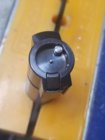carlsbad
Lions don't lose sleep over the opinions of sheep.
Thanks BC'z. Sorry that wasn't clear.
This firing pin as found was .078 diameter in a .086 hole. I'm sure the guy was having some cratering. There was some damage to the end of the pin, probably from the brass pinching between the pin and the wall of the hole. The issues machined off. Pin is now .059. Hole is .060. I'll post photos of the "as left" later or tomorrow. --Jerry
This firing pin as found was .078 diameter in a .086 hole. I'm sure the guy was having some cratering. There was some damage to the end of the pin, probably from the brass pinching between the pin and the wall of the hole. The issues machined off. Pin is now .059. Hole is .060. I'll post photos of the "as left" later or tomorrow. --Jerry











